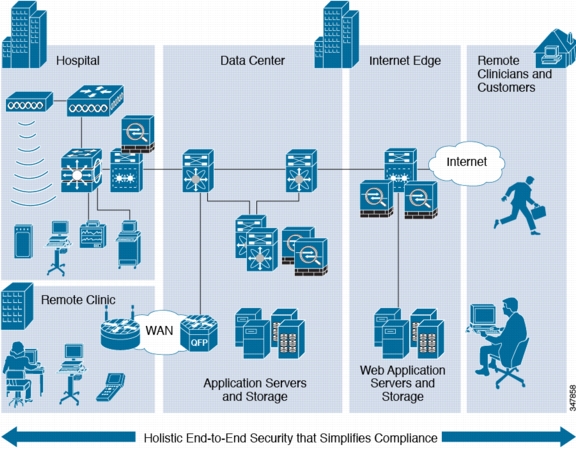

-
Cisco Compliance Solution for HIPAA Security Rule Design and Implementation Guide
-
Authors
-
Preface
-
Solution Overview
-
HIPAA and the Solution Framework
-
Solution Architecture
-
Solution Implementation
-
Component Assessment
-
Summary
-
Appendix A: Bill of Material
-
Appendix B: Cisco Products and Software Versions
-
Appendix C: Reference Architecture Assessment Report—Cisco Healthcare Solution
-
Appendix D: Simplified Crosswalk—HIPAA, PCI, and SOX
-
Appendix E: Detailed Full Running Configurations
-
Table Of Contents
HIPAA Solution Summary Results
Solution Overview
Introduction
Cisco customers have stated that the Health Insurance Portability and Accounting Act (HIPAA) is vague, and they are not sure how it directly applies to their enterprise networks. Many do not understand how HIPAA relates to technology and infrastructure. They have asked Cisco to provide guidance that shows this relationship. This Cisco Compliance Solution for HIPAA Security Rule provides a reference architecture designed to help covered entities and business associates simplify compliance with the HIPAA Security Rule. The guidance in this document maps architectures and products to the HIPAA Security Rule technical safeguards, standards, and implementation specifications.
Chapter 2 "HIPAA and the Solution Framework," describes the elements that make up the solution framework. The solution framework organizes the scope of the Protected Health Information (PHI) data environment for contextual reference. Chapter 3, "Solution Architecture," discusses what IT should consider when designing their network to best align with HIPAA Security Rule implementation specifications. For specific designs referencing these architectures, read Chapter 4, "Solution Implementation." In Chapter 5, "Component Assessment," each component is individually assessed for its capabilities, and configuration examples are given to demonstrate this utility. The complete assessment report authored by Verizon is located in Appendix C, "Reference Architecture Assessment Report—Cisco Healthcare Solution."
The Cisco Compliance Solution for HIPAA Security Rule was built and tested using a holistic enterprise perspective including the following:
•
Endpoint consideration—PHI systems and devices, including wireless devices
•
Administrative concerns within scope of HIPAA
•
Cisco, RSA, EMC, and Hytrust network infrastructure and architectures comprising data center, Internet edge, and healthcare facilities that simplify the process of meeting the HIPAA Security Rule implementation specifications.
Figure 1-1 shows an example of the enterprise architecture.
Figure 1-1 Enterprise Architecture
Solution Methodology
Cisco customers have asked for clarification on how HIPAA relates to Cisco architectures and individual components within the architecture. To address this challenge, Cisco contracted Verizon Business to "reassess" an existing compliance solution that protects credit card data; Cisco Compliance Solution for PCI DSS 2.0. The strategy is to use a common control structure that addresses multiple compliance standards using a "unified compliance" mindset. The intent is that regardless of the type of sensitive electronic data (payment or healthcare), a single security strategy should meet the needs of an organization to protect it from a compliance perspective.
Target Market/Audience
The audience for this solution includes compliance managers, as well as technical teams seeking guidance on how to design, configure, and maintain their IT architecture and components for HIPAA Security Rule compliance. Although the diagrams and references relate to healthcare institutions, the reference architecture also applies for other covered entities and business associate networks in relation to the HIPAA Security Rule.
Solution Benefits
The solution demonstrates how to design end-to-end enterprise systems that conform to the HIPAA Security Rule safeguards and provides the following benefits:
•
Insight into the Cisco enterprise architecture and the controls used to address HIPAA Security Rule technical safeguards
•
A detailed analysis and mapping of Cisco and partner components and their relationship with HIPAA Security Rule controls
•
A scalable set of reference designs that can be used to establish the security controls necessary to achieve compliance with the HIPAA Security Rule
•
A centralized management "tool kit" simplifying the operational challenges of an enterprise network
•
The central focus of this design guide is the implementation of an architecture that meets the HIPAA safeguards; in addition, using the recommended segmentation strategies and additional quality of service (QoS) parameters can increase performance.
HIPAA Solution Summary Results
Table 1-1 lists the HIPAA citations that were addressed within the solution.
Compliance with the HIPAA Security Rule was assessed by an external auditor, Verizon Global Services Group.
Note
This document does not guarantee compliance with the HIPAA Security Rule.


